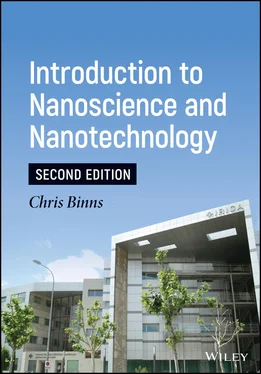2 2 Hinds, W.C. (1999). Aerosol Technology. New York: Wiley.
3 3 Seinfeld, J.J. and Pandis, S.N. (1997). Atmospheric Chemistry and Physics: From Air Pollution to Climate Change. New York: Wiley.
4 4 Champion, J.A., Walker, A., and Mitragotri, S. (2008). Role of particle size in phagocytosis of polymeric microspheres. Pharmaceutical Research 25: 1815–1821.
5 5 Roberts, J. and Quastel, J.H. (1963). Particle uptake by polymorphonuclear leucocytes and Ehrlich ascites‐carcinoma cells. Biochemical Journal 89: 150–156.
6 6 Hoet, P.M., Brüske‐Hohlfield, I., and Salata, O.V. (2004). Nanoparticles – known and unknown health risks. Journal of Nanobiotechnology 2: 12. http://www.jnanobiotechnology.com/content/2/1/12.
7 7 Renwick, L.C., Donaldson, K., and Clouter, A. (2001). Impairment of alveolar macrophage phagocytosis by ultrafine particles. Toxicology and Applied Pharmacology 172: 119–127.
8 8 Brook, R.D., Rajagopalan, S., Pope, C.A. 3rd et al. (2010). Particulate matter air pollution and cardiovascular disease: an update to the scientific statement from the American Heart Association. Circulation 121: 2331–2378.
9 9 Miller, M.R., Raftis, J.B., Langrish, J.P. et al. (2017). Inhaled nanoparticles accumulate at sites of vascular disease. ACS Nano 11: 4542–4552. https://doi.org/10.1021/acsnano.6b0855.
10 10 Boyles, M.S.P., Stoehr, L.C., Schlinkert, P. et al. (2014). The significance and insignificance of carbon nanotube‐induced inflammation. Fibers 2: 45–74. https://doi.org/10.3390/fib2010045.
11 11 Szentkuti, L. (1997). Light microscopical observations on luminally administered dyes, dextrans, nanospheres and microspheres in the pre‐epithelial mucus gel layer of the rat distal colon. Journal of Controlled Release 46: 233–242.
12 12 Zvyagin, A.V., Zhao, X., Gierden, A. et al. (2008). Imaging of zinc oxide nanoparticle penetration in human skin in vitro and in vivo. Journal of Biomedical Optics 13: 064031.
13 13 Kreilgaard, M. (2002). Influence of microemulsions on cutaneous drug delivery. Advanced Drug Delivery Reviews 54: S77–S98.
14 14 Directive 2008/50/EC of the European Parliament and of the Council of 21 May 2008 on ambient air quality and cleaner air for Europe. http://data.europa.eu/eli/dir/2008/50/oj.
15 15 Walton, A.J. (1983). Three Phases of Matter. Oxford: Clarendon Chapter 13.
16 16 Fan, J., Rosenfeld, D., Zhang, Y. et al. (2018). Substantial convection and precipitation enhancements by ultrafine aerosol particles. Science 359: 411–418.
17 17 Clarke, A., Kapustin, V., Howell, S. et al. (2003). Sea‐salt size distributions from breaking waves. Journal of Atmospheric and Oceanic Technology 20: 1362–1374.
18 18 O'Dowd, C., Facchini, M.C., Cavalli, F. et al. (2004). Biogenically driven organic contribution to marine aerosol. Nature 431: 676–680.
19 19 Creamean, J.M., Cross, J.N., Pickart, R. et al. (2019). Ice nucleating particles carried from below a phytoplankton bloom to the arctic atmosphere. Geophysical Research Letters 46: 8572–8581. https://doi.org/10.1029/2019GL083039.
20 20 Donarummo, J. Jr., Ram, M., and Stolz, M.R. (2002). Sun/dust correlations and volcanic interference. Geophysical Research Letters 29: 75‐1–75‐4.
21 21 Clement, D., Mutschke, H., Klein, R., and Henning, T. (2003). New laboratory spectra of isolated ‐SiC nanoparticles: comparison with spectra taken by the Infrared Space Observatory. Astrophysical Journal 594: 642–650.
22 22 Postberg, F., Kempf, S., Srama, R. et al. (2006). Composition of Jovian dust stream particles. Icarus 183: 122–134.
23 23 Bentley, M., Schmied, R., Mannel, T. et al. (2016). Aggregate dust particles at comet 67P/Churyumov–Gerasimenko. Nature 537: 73–75. https://doi.org/10.1038/nature19091.
24 24 Eto, K. (1997). Pathology of Minamata disease. Toxicologic Pathology 25: 614–623.
25 25 Yirsaw, B.D., Megharaj, M., Chen, Z., and Naidu, R. (2016). Environmental application and ecological significance of nano‐zero valent iron. Journal of Environmental Sciences 44: 88–98. https://doi.org/10.1016/j.jes.2015.07.016.
26 26 Wang, C.B. and Zhang, W.X. (1997). Synthesising nanoscale iron particles for rapid and complete dichlorination of TCE and PCBs. Environmental Science and Technology 31: 2154–2156.
27 27 Crane, R.A. and Scott, T.B. (2012). Nanoscale zero‐valent iron: future prospects for an emerging water treatment technology. Journal of Hazardous Materials 211–212: 112–125. https://doi.org/10.1016/j.jhazmat.2011.11.073.
28 28 Jabeen, H., Kemp, K.C., and Chandra, V. (2013). Synthesis of nano zerovalent iron nanoparticles – graphene composite for the treatment of lead contaminated water. Journal of Environmental Management 130: 429–435. https://doi.org/10.1016/j.jenvman.2013.08.022.
29 29 Celik, G., Kennedy, R.M., Hackler, R.A. et al. (2019). Upcycling single‐use polyethylene into high‐quality liquid products. ACS Central Science 5: 1795–1803. https://doi.org/10.1021/acscentsci.9b00722.
30 30 Hedayati, A., Barnett, C.J., Swan, G., and White, A.O. (2019). Chemical recycling of consumer‐grade black plastic into electrically conductive carbon nanotubes. Journal of Carbon Research 5: 32. https://doi.org/10.3390/c5020032.
31 31 Luong, D.X., Bets, K.V., Algozeeb, W.A. et al. (2020). Gram‐scale bottom‐up flash graphene synthesis. Nature 577: 647–651. https://www.nature.com/articles/s41586‐020‐1938‐0.
1 1Ocean bed hydrothermal vents are fissures on the sea floor from which geologically heated water erupts into the surrounding cold water. They are mineral‐rich and support various deep‐sea creatures.
2 2Supernovae are massive stellar explosion that occurs at the end of the life of massive stars. After the star exhausts its supply of hydrogen it collapses under gravity and, if it is above a critical mass (several times that of our sun), the resulting implosion at the core produces a thermonuclear explosion, which for a period of weeks can produce billions of times more power than a normal star.
3 3More precisely it is released when plankton of the animal kind (zooplankton) eat plankton of the plant kind (phytoplankton).
Конец ознакомительного фрагмента.
Текст предоставлен ООО «ЛитРес».
Прочитайте эту книгу целиком, купив полную легальную версию на ЛитРес.
Безопасно оплатить книгу можно банковской картой Visa, MasterCard, Maestro, со счета мобильного телефона, с платежного терминала, в салоне МТС или Связной, через PayPal, WebMoney, Яндекс.Деньги, QIWI Кошелек, бонусными картами или другим удобным Вам способом.












